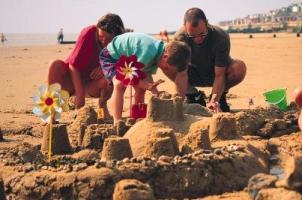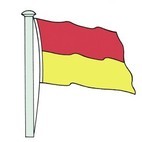The beach is a great place to be, especially during the summer months, and there are some simple steps you can follow to stay safe.

Know your flags!
 | When the red and yellow flag is flying, it shows that the beach patrol are on duty |
| The red flag indicates DANGER! Never enter the water when this is flying. |
| When the black and white chequered flag is flying, this means an area of water has been marked for watercraft. For your own safety, do not swim in these zones. |
| The orange windsock flying shows that the wind conditions are especially dangerous. Under no circumstances should you take an inflatable out onto the sea. |
Find the red and yellow flags and swim between them. Always read and obey any safety signs but if in doubt, ask one of our Beach Patrol Team. Always swim where there are other people around or better still, swim with a friend!
Inflatables
Inflatables are great fun especially in a pool but can pose a danger when used in the sea. If you insist on bringing one with you to the beach, there are some precautions you should follow:
- Children's inflatables should always have a line connected which is held securely by an adult on the shore.
- Make sure children are within easy reach at all times.
- NEVER take an inflatable out in strong winds or when you see large waves.
A wind blowing off shore can be misleading - the sea can look calm and safe by the beach but can very quickly sweep an inflatable away from the shore. It only takes a slight breeze to blow an inflatable out to sea.
What to avoid when swimming
When swimming if you get into trouble stick your hand in the air and shout for help. If you see someone in difficulty, alert the Beach Patrol immediately. If none are visible, call 999 and ask for the Coastguard.
Keep away from piers, groynes, harbour walls, breakwaters, jetties, outflow pipes and sea defences as in certain conditions they can cause serious injury. This is because conditions around these structures are changeable with rips, undertows, large breaking waves and unpredictable wake from passing vessels. The water's depth can also change suddenly and without warning.
Keep an eye on the tide - always check the tide before you enter the water. Also you must be careful that you are not cut off by a tide when walking along the shore.
Be safe in the sun!
No one wants a spoilt day on the beach because of too much sun. Spending even a short time in the sun can give you sunburn, heat exhaustion or heat stroke which is why you need to protect yourself by:
- slipping on a hat
- slipping on a long-sleeved t-shirt
- using appropriate sunscreen
The hottest part of the day is between 11am and 3pm so try to avoid being in the direct sun during these times where possible.
Our Beach Patrol Teams are there to help you make your stay on the beach as safe as possible - do not hesitate to speak with them if you have any queries or require further information.



 We are currently experiencing intermittent issues with public access, we apologise for any inconvenience this may cause.
We are currently experiencing intermittent issues with public access, we apologise for any inconvenience this may cause.

